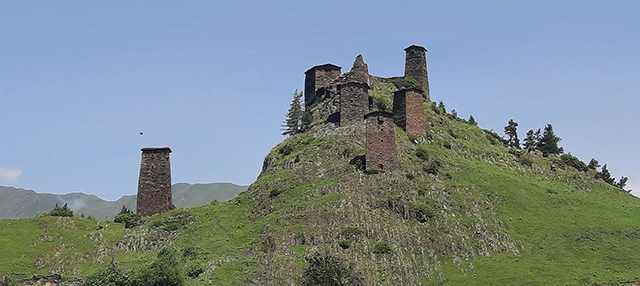There’s something about old castles and fortifications that elicit a variety of emotions. These immense structures connect us to a past mostly only seen in history books and movies. The ability to see the places our ancestors lived, dined, slept, fought, and potentially died in is an incredible experience.
Georgia is home to an extensive portfolio of these old fortifications. Some have lost their former glory, crumbling to only a vague reminder of a forgotten bastion of empires of yesteryear. However, some have maintained their presence or been restored by the benevolence of generous organizations. One of these, buried in the northeastern high mountains of Tusheti, looms over the town that once called it home in times of invasion.
Keselo Fortress is a castle is nestled in the northern part of the Greater Caucasus Mountains, only 8.84 km (5.49 mi) from the Russo-Georgian border. Across this border sits Chechnya and Dagestan, with the historic Georgian winemaking region of Kakheti to the south. The area is isolated from the rest of Georgia during the late fall, winter, and early spring months by impassable mountain roads and heavy snowfall.
The town of Omalo, with a full-time population of less than 50 people, is nestled around the base of this castle. Its inhabitants, the early Tush people, are believed to be an amalgamation of Kakhetian and Ingusheti. These people, over centuries, made the mountains their home due to the safety and natural defenses they afforded them.
With the introduction of Christianity in the early 4th century AD, many of those that held onto their pagan beliefs used the mountains as a refuge. In fact, this region of Georgia was one of the last to convert to Christianity sometime around the mid-18th century. Omalo would have been a haven for those seeking to continue their ancient beliefs.
Keselo Fortress itself was estimated to have been built in its current configuration around the Mongol invasions in the 1230s, with a total of 13 towers. When raiding forces were detected, the local population of Omalo would abandon their village and flee into the fortress complex. Bringing only valuable items and limited livestock, they would store these in the lower levels of the towers. Women, children, and other non-combatants would settle in the mid-levels, and the fighting men of the village would then fill the top levels of the towers with bows, and later firelock muskets called “Tbilisuri Dambacha” or “Machakhela,” at the ready. These muskets were of a unique design specific to the region, with a narrow buttstock. The men would fire upon the raiders, who would have difficulty generating casualties among the entrenched defenders.
These towers, built of locally sourced slate/shale rock could easily take the brunt of the enemy’s weapons. Ideally, the raiders would then only take what they could, while likely suffering casualties in the process before being forced away by the fire from the towers. The residents would then begin the rebuilding of their village.
One particular story illustrates an interesting example of this defense model. In one legend, the defenders of the Keselo Fortress defeated a large Dagestani raiding party with one shot. In the legend, a Dagestani raiding party had come to pillage and rampage through the Tush people’s land, taking valuable grain and livestock. When approaching Omalo, the locals fled to the castle according to their traditions.
For days, the Dagestani troops raided the village, taking food, wine, and beer for their own. The troops took to staying in the village, occasionally exchanging fire with the defenders and having raucous drinking parties in their occupied village. Finally, in an effort to draw out the defenders or make them abandon their lands, the Dagstani warlord took to a hilltop opposite the castle on the other side of the village. He stood atop this hill making boastful statements, taunting the defenders and daring them to take the field against him.
One of the defenders called to a friend who was known to be an exceptionally good shot with his Machakhela musket. He instructed him to use a double charge of gunpowder when loading, and take careful aim at the warlord atop the hill. The man aimed and fired, striking and killing the warlord almost instantly. As was Dagestani traditional belief at the time, if a warlord was killed, it was seen as the worst possible omen. The raiding party promptly left, taking their fallen leader with them. The people of Omalo had virtually saved the Tush people from ruin.
While a legend is typically born of some truth, this one deserves due scrutiny, particularly with regards to the ballistics behind this legendary kill. The Machakhela muskets, like many of the time, were not known for exceptional accuracy, unlike those models made in Western arms factories for specific Light Foot or “Ranging” companies.
These units were specifically trained, exponentially more than regular line infantry units, to shoot with near-unrivaled accuracy. This precision is taught through weapons handling and careful construction of the ammunition.
The Machakhela musket was not a “standard” musket like Western ones. Such famed weapons as Great Britain’s “Brown Bess” Land Pattern Musket, the Prussian Potzdam Musket, or France’s Charleville Musket, were all factory made. These had exact standards and were made to a specific measurement. But Machakhela muskets were each unique to their owner. Made in Tbilisi or other urban centers where foundries were available, each musket often reflected the family history of the owner. Very little was made to an exact standard, instead made to the desires of the individual ordering the piece.
As a result, while it’s possible that the musket the Omalo shooter held could have delivered that precise low, it’s less likely than if it had come from a Western sharpshooter. Then, there’s the distance covered. The straight line distance between the tower the shot most likely came from and the hill the warlord would have stood on is 270 meters (886 ft). This is a considerable distance for an accurate shot to be made with a firelock like a Machakhela.
The maximum distance of a musket overall is often over 1,000 meters, so the target is well within range, but the “effective range” has to be considered here. The muskets of this time were smoothbore, meaning they had no grooves inside the barrel. These grooves, or rifling, exponentially increase the accuracy. Without them, the realistic range of hitting the intended target is much lower.
Most military doctrine of the time places the effective range of these weapons around 150 meters. It is at this distance that a musket could realistically be expected to hit within a 50 centimeter (20 inch) circle. However, this is not definitive. There are several historical instances of hitting targets as far as 300 meters, something termed to be “within musket-shot.” These historical instances stress the importance of careful cartridge construction.
With this analysis, we come to a reasonable conclusion of the probability of the legend. It can be within realistic probability that, with a well-cared-for musket, carefully constructed cartridge, and decent experience firing at longer ranges, the Omalo shooter could have lethally hit a man-sized target at 275 meters. It is the author’s personal assessment, having fired smoothbore muskets himself, that the shooter would have approximately a 65% chance of a hit. This is assuming the above three attributes are true, there is no interference (such as heavy wind), and the target was not moving.
Yet, whether this legend is true or not is immaterial to the beauty and history of the region. This, combined with the unique food, drink, and incredible flora, make it a must see for any visitor to Georgia. So much of the country has impressive windows into the past. Tusheti offers an almost untouched look into these hearty mountain people’s way of life and their traditions that continue to this day.
This article was made possible with the support and effort of the United Nations FAO and Elkana. Their financial and logistical resources bring awareness to the importance of Georgian ecotourism and sustainability of natural resources. Elkana and FAO are instrumental in helping people everywhere make their next destination in Georgia.
By Michael Godwin














